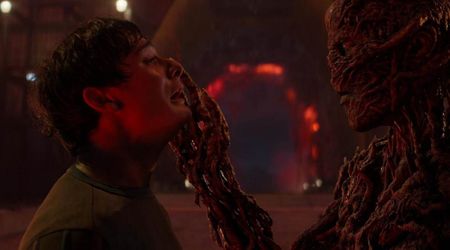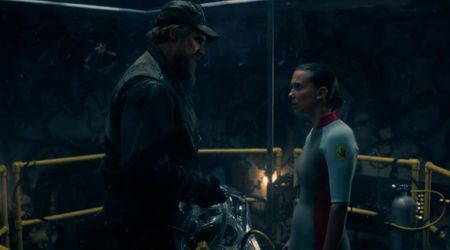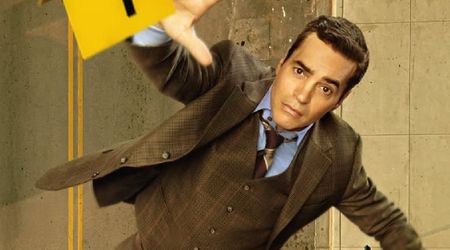Netflix's Evil Genius: The true story behind the weirdest bank heist and the woman at the centre of it

WARNING: SPOILERS
Evil Genius: The True Story of America's Most Diabolical Bank Heist is a true crime four-part docuseries from Netflix about the murder of Brian Wells. The 2003 incident made international headlines and is referred to very often as the "collar bomb" or the "pizza bomber" case. The streaming giant released the series on May 11.
The co-director of the series, Trey Borzillieri, got the idea for the show after he watched Paradise Lost: The Child Murders at Robin Hood Hills. He started becoming obsessed with researching about what happened in the case of Brian Wells' murder after new evidence emerged that suggested the pizza delivery man may have been a victim of a more diabolical scheme and was forced into robbing a bank with a bomb strapped to his chest.
Borzillieri started interviewing many people around Erie, Pennsylvania where the murder took place. Then, two years after the death of Wells, he got in touch with Marjorie Diehl-Armstrong and they started talking about the case.
The woman was one of the only people who had any answers for Borzillieri about the case which was considered a cold case at that point. He spent a considerable amount of years researching and conducting his own investigation into the case. This included talking to Diehl-Armstrong regularly while she was in prison.
The weirdest bank heist
When it comes to high-profile bank heists, this is definitely one of the strangest. It all starts in August 28, 2003, at 2:28 p.m.
A man walks into a bank with a bomb around his neck. A white shirt hides the homemade device but it's noticeable to anyone who would have seen him. He hands a teller at the counter a detailed note that demanded $250,000. The moment he left the bank the teller dials 911 and the authorities are able to apprehend him not far from the bank.
He tries telling them that he has a bomb under the shirt and that it will go off soon if nothing is done about it but it takes a while for the bomb squad to get to the scene. Shortly before they arrive, the beeping increases in speed and detonates. Wells had a massive hole in his chest that was caused by the explosion and he dies of his injuries before the bomb squad can reach the scene.
The Netflix series about the heist that turned into murder raises a lot of questions that will keep you awake and wondering what happened.
Was Brian Wells a victim to someone's twisted scheme or was he in on it the whole time? If he was truly a victim, who is the mastermind behind the weirdest bank heist ever committed?
Directed by Barbara Schroeder and Trey Borzillieri, the four-part series looks at all the evidence that was part of the high-profile case that took place in Erie.
As far as bank heists go, this one started like any other but had a M Night Shyamalan-esque twist. Wells had a bomb strapped to his chest and handed a note asking for half a million in cash, however, the teller was only able to give him $8,000.
He collects the money he got and takes a lollipop from the counter on his way out of the bank. The teller immediately calls 911 and informs the authorities about what happened.
When they finally apprehended Wells, they found that he had many pages filled with the same handwriting as the one on the demand note from the bank. The pages were filled with what can only be described as rambling instructions for a strange scavenger hunt for the keys and the combinations that will be needed to remove the collar from around Wells' neck.
Wells never had a chance
The task was for Wells to follow all the instructions that would take him across Erie in search of the keys and combinations but his desperate scavenger hunt came to an abrupt halt because he was caught near the bank and handcuffed. Once the police at the scene realised that he was indeed wearing a bomb, they stayed far away from him while keeping their weapons trained on him.
This scene was broadcast internationally and everyone waited with bated breath to see what the outcome of the tense stand-off was going to be.
Wells told the police at the scene was that he was just a delivery man and he was tricked into this whole situation. He said: "I don't know if I have enough time now."
The police didn't try to approach him because his voice sounded a little too calm for someone with a homemade bomb on his chest.
As he sat on the sidewalk, he said: "I am not lying. It's gonna go off." That's when the collar starts beeping. Everyone watching could see that Wells was getting more and more desperate and he was literally trying to wriggle his way out of the bomb the faster the beeping became. Then, suddenly, the bomb exploded and Wells died of his injuries shortly after.
The bomb squad finally arrived and they had to saw off Wells' head to be able to remove the collar bomb.
The days that followed after the heist and murder were some of the strangest that the small city of Erie had seen.
A former colleague of Wells, Robert Pinetti, was found dead inside his own home. The cause of death was an apparent drug overdose.
Bill Rothstein, another man, calls and tells the police that there was the dead body of a man in his garage refrigerator. The body turned out to be James Roden, who was the boyfriend of a woman called Marjorie Diehl-Armstrong. Rothstein described her to police as a woman who was a master manipulator.
Diehl-Armstrong ended up being the focus of the investigation after that. Investigators found out that she was a Class A student who was also very good looking. She was also discovered to have bipolar disorder. The biggest revelation came when the investigators found out that in 1983 she had murdered her first boyfriend and was able to argue self-defense in court. She was subsequently acquitted at the trial.
This should have made the case easy for investigators but, unfortunately, it didn't.
A drug addict by the name of Kenneth Barnes told investigators that Diehl-Armstrong was the one who planned the bank heist because she needed the money to hire him as a hitman to kill her ageing father. She has accused her father of spending the money that was supposed to be her inheritance.
Rothstein, the man who called about the body in the fridge, happened to be a former boyfriend of Diehl-Armstrong. He was eccentric and a brilliant mechanic. Rothstein was also the one who allegedly designed and made the bomb that killed Wells.
Co-director Borzillieri communicated with Diehl-Armstrong for more than 10 years. They spoke over the phone and through writing and the prime focus of their conversations was Brian Wells and his tragic death.
Borzillieri told AFP in an interview: "In the beginning, very much like the residents of Erie and law enforcement, I believed that he was involved in this case and did so for a good long while."
"By the end of the journey, my opinion is that he was innocent."
When the FBI conducted a long investigation into this complicated case, they found out that Wells was actually a "co-conspirator" in the heist and this meant that the other suspects would not end up getting the death penalty for his murder.
A diabolical, maniacal game
FBI Special Agent Jerry Clark said about the case: "I think the whole plan initially started out as a way for them all to make some money. But it developed into more than just making money. It became almost a game to them. A diabolical, maniacal game."
Co-director Shroeder is a also a journalist and the character of Marjorie Diehl-Armstrong really fascinated her. The woman, unfortunately, died of cancer in 2017. She was 68-years-old.
Shroeder said of Diehl-Armstrong: "Marjorie can be abrasive and off-putting, but she is also fascinating. She is like a train wreck where you have to turn your head and look and then she keeps your attention because she is eloquent."
"She was the most fascinating female I have ever come across."
In the final episode of the series, a clue that was not looked at before by any of the investigating agencies was presented to the audience. It came in the form of a testimony from a woman who goes by the name of Jessica Hoopsick.
Hoopsick has claimed that she and Wells developed a close friendship before his death and that she had also developed some feelings for him even though he was her paying client. She also said that she was determined to resurrect his reputation and his name after the disastrous Pizza Bomber case of 2003.
The shocking revelation occurred when Hoopsick said that Diehl-Armstrong and her crew paid her money to find an gullible target for their grand heist plans. Hoopsick said that she was the one who suggested Wells.
She said in the series: "He had no idea what would happen to him."
Critique
Netflix's docuseries has a 78% freshness rating on Rotten Tomatoes which falls under the "That seems like it's worth the watch" category for people who haven't seen it yet. The consensus on the site reads: "Evil Genius makes up for a lack of conviction and nuance with an intriguing sense of discovery and plenty of entertaining insanity." Many critics gave either bad or mixed reviews for the show.
In my opinion, however, the four-part docuseries is definitely worth watching although it does leave us wondering whether the mastermind behind the heist and the murders was actually Marjorie Diehl-Armstrong.
At the end of the day, the open endedness of the show's finale is what makes any audience who watches it sit back and think about it.
If you ask me whether the show is binge worthy, my answer is a yes.










